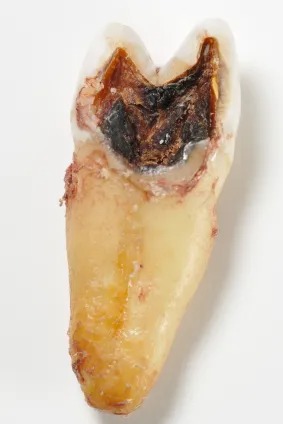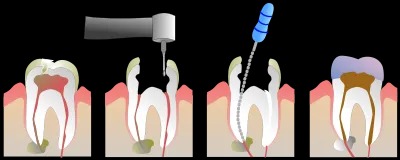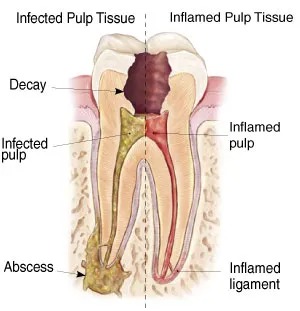Signs of Tooth Loss
Primarily, it is the lack of good oral hygiene practices that can lead to tooth decay, gingivitis and abscesses of the teeth. A tooth abscess occurs when harmful oral bacteria accumulate around the root or dead pulp of a tooth and develop into a pocket of pus. Unless this abscess is treated, the bacteria-rich pus will continue to erode the decaying tooth and reach into the surrounding gums, possibly infecting other teeth as well.

Symptoms of a tooth abscess include:
- Throbbing, sharp or shooting pain (occasionally an abscess may be painless)
- Swelling at the site of the abscess
- Facial pain on the same side as the abscess
- Chronic halitosis due to the overwhelming presence of anaerobic bacteria contributing to the bacterial infection
- Bitter and/or sour tastes in the mouth
- Fever
- Swollen neck glands
Three types of dental abscesses can affect the teeth and gums: gingival, periapical and periodontal.
- A gingival abscess affects the gums but does not infect teeth roots because it originates from bacteria being forced into the gum area above the teeth rather than tooth decay. Brushing too hard or punctures from sharp food or toothpicks are common reasons for someone developing gingival abscesses.
- Periapical abscesses infect the middle or root of a tooth that is decaying or already dead. Resulting from dental caries and poor oral hygiene, periapical abscesses may erode tissues and spill into the maxillary sinus cavity causing osteomyelitis, or a bone infection. People suffering from this type of abscess may experience nausea due to an infection seeping into the nasal cavities and eventually into the stomach. Severe halitosis is also another sign that a periapical abscess is festering in the mouth. Treatment includes draining the infection by drilling into the tooth's pulp, a regimen of antibiotics and/or extraction of the abscessed tooth.
- The most serious type of abscess is a periodontal abscess which can rapidly lead to destruction of the bony support structure keeping teeth in place. A periodontal abscess not only infects a tooth but can also reach the bony structure underlying the teeth. Symptoms include sharp pain at the base of the infected tooth, bleeding gums, halitosis, loose teeth and thick coverings of tartar and plaque discoloring teeth. Periodontal abscesses require immediate attention by a dentist more so than the other two types of abscesses because of the danger of bacteria infiltrating the bloodstream and causing heart or respiratory problems.
Dental and gum abscesses do not go away on their own. Depending on the type and severity of the abscess, treatment may include one or more of the following:
- Root canals when there is a possibility the tooth may be saved
- Surgery if the abscess is large and needs to be drained or if several teeth need to be removed
- Antibiotics to prevent infection from worsening. An aggressive approach to an antibiotic treatment plan may be implemented if the abscess is serious and a dentist thinks the potential for developing a brain abscess, endocarditis or pneumonia exists
What is a Root Canal?
Root canals are done when a tooth can be repaired and saved from extreme decay due to abscesses and poor oral hygiene. The procedure may take one to two hours and involves removing the pulp and nerve tissue of a tooth so that the dentist can sterilize the inside of the tooth and seal it without leaving any bacteria behind. Teeth do not necessarily require nerve tissue to continue functioning since this tissue exists only to provide hot or cold sensations. As long as the root and underlying bone support of a tooth appears intact, a dentist may be able to save a tooth affected by an abscess.

How to Prevent Dental and Gum Abscesses

The best way to prevent oral abscess eruptions is to practice excellent oral health. Brushing twice a day, flossing and rinsing with mouthwash that contains ingredients beneficial to the elimination of anaerobic bacteria and other harmful mouth debris will give you healthy gums and teeth as well as fresh breath.
While the majority of over the counter oral hygiene products claim to give you good dental checkups if you use them regularly, the ingredients used in formulating these products may actually exacerbate halitosis and anaerobic bacterial growth. Substances like alcohol, which promotes dry mouth and oral infections, and sodium lauryl sulfate, an abrasive foaming agent found in many toothpastes, actually supply harmful oral bacteria with food by reducing saliva flow and sloughing off mouth tissue on which bacteria feed.
Only TheraBreath Oral Hygiene products can provide you with the benefits of ingredients that are specifically designed to eliminate the bad breath and funky taste associated with the development of oral abscesses. Created by bacteriologist and dentist Dr. Harold Katz, TheraBreath toothpastes, rinses and gargles contain naturally powerful ingredients like OXYD-8, a compound that increases saliva flow and enriches the mouth with oxygen molecules, and tea tree oil combined with xylitol to attack halitosis and bad tastes.
Start taking charge of your oral health by using TheraBreath Oral Hygiene products and the power of their laboratory-tested ingredients.
